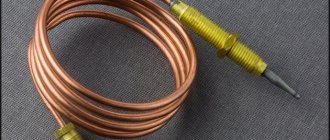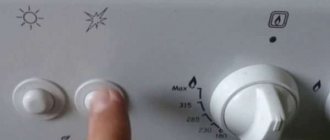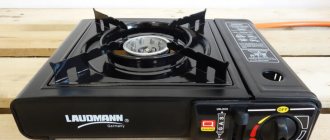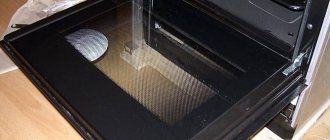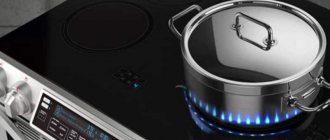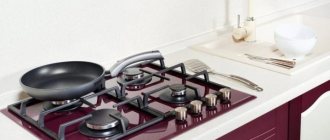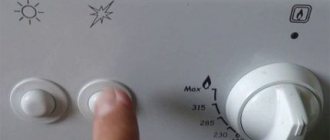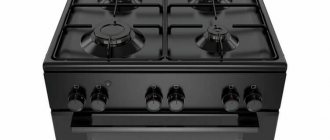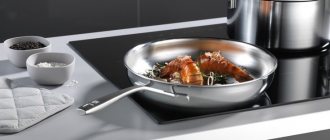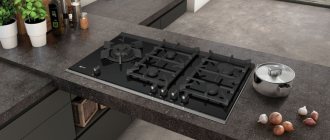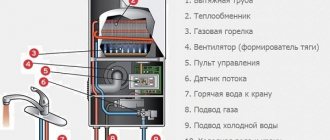Installation and connection of new equipment
The gas stove replacement scheme is as follows:
- dismantling obsolete or unusable equipment;
- faucet replacement;
- installation of a new slab;
- its connection;
- leak testing;
- acceptance of work by the Mosgaz service in Moscow, Lenoblagaz in St. Petersburg, and so on.
Dismantling a gas stove
To dismantle outdated equipment, you must:
- close the tap located on the pipe to turn off the gas supply;
- check the absence of gas by turning on one of the burners;
- disconnect the gas supply;
- Disconnect the stove from electricity (if necessary).
After completing these operations, the stove can be removed from the kitchen.
Disconnecting old equipment from gas and electricity supplies
Replacing the faucet
If the gas valve does not meet safety requirements or does not completely shut off the gas supply, then before installing new equipment, it is recommended to replace the valve.
As a rule, the equipment is installed and connected by the gas service, since in order to increase the level of safety, it is recommended to disconnect the entire entrance from the gas supply. However, if it is possible to cover it in an individual living space, then having certain skills and all the necessary equipment, you can do the work yourself.
The valve is replaced according to the following scheme:
- crane dismantling. In most cases, threaded valves are installed on gas systems in apartment buildings, the dismantling of which is quite easy. However, in old houses, welded valves can also be installed, the dismantling of which is carried out using a grinder (exclusively after turning off the media supply);
If the work is carried out without turning off the gas and by one person, then after dismantling the tap, a special plug is installed on the pipe. If there are two or more workers, you can plug the pipe with your hands.
- if the thread on the gas pipe is damaged or missing because welded equipment was installed, then at the next stage the thread is cut using special equipment;
- thread sealing;
- removing the plug and installing a new faucet.
Sequence of actions when replacing a gas valve
Installation and connection of a new gas stove
A new slab is installed in the prepared area. When installing, you must level it horizontally. To achieve this, most modern Hephaestus stoves are equipped with adjustable legs. In the absence of such a function, alignment is carried out using various spacers.
Alignment by level
Next, the flexible line is connected to the plate and pipe. For this:
- the thread on the liner (pipe) is sealed with the selected material;
- the eyeliner is fixed;
- Connection to a gas stove is made in a similar way;
Gas hose connection
- if necessary, the stove is connected to the power supply system.
How to install and connect a gas stove yourself, watch the video.
Leak test
After completing all work, you need to check the connections for leaks. The operation is performed in the following order:
- preparing a soap solution;
- applying the solution to the connecting nodes.
If the solution begins to form bubbles, the connection is not sealed and the problem must be corrected before putting the system into operation. The absence of bubbles indicates that the system is completely sealed.
Presence of a leak in the gas supply system
Acceptance of work by the gas service
After all the work has been completed, an application is sent to the gas service to put the stove into operation. At the appointed time, specialists will check the correct connection and tightness. Based on the inspection, permission will be given to use the gas stove or an order to eliminate the identified deficiencies.
If you carry out all the work according to the attached instructions and in a well-ventilated area, you can completely avoid negative consequences when performing the work and save on paying for specialist services.
Preparing for the connection process
Preparation for connecting the stove consists of selecting a suitable place to place the cylinder, selecting materials and components, as well as simple modifications to the gas equipment.
Choosing a location for the cylinder
The main condition when choosing a place to place a gas cylinder is to ensure the safety of people.
Important! It is not allowed to place a container with gas in living rooms, as well as in those places that communicate directly or through ventilation with habitable premises.
Liquefied gas has a high density, so it quickly accumulates on the lower floors. In this regard, it is prohibited to install gas equipment in the basement of a building or underground, that is, below ground level. This is explained by the fact that in an ordinary room an insignificant leak does not pose a significant threat due to natural ventilation, but in basement areas the gas is not completely ventilated and can accumulate to a dangerous concentration that threatens an explosion.
According to the standards, gas cylinders are allowed to be placed only in private houses or in apartments located in two-story buildings (no more) . In this case, there cannot be more than one cylinder, and the container should be installed half a meter from the stove itself and one meter from the heating equipment.
To ensure proper safety of the installation and prevent access to the equipment by children and strangers, it is recommended to place the cylinder in a room with a separate entrance or outside the room on a pallet in a metal cabinet, the height of which is 20-30 cm higher than the dimensions of the gas container. But this cabinet should not be exposed to direct sunlight to prevent it from heating above +40°C, as well as raindrops to prevent moisture from penetrating inside.
When installing equipment outdoors, you also need to take into account the temperature around it. The composition of bottled gas includes propane and butane, and at temperatures below 0°C the second component will stop evaporating. When operating in a lower temperature range, gas may stop flowing to the stove completely.
Advice! If it is necessary for the stove to function properly in winter, you should purchase cylinders with winter gas mixtures that evaporate at air temperatures down to -40°C.
Jet selection
Usually, nozzles for natural gas are pre-installed on a gas stove, and nozzles for liquefied gas are included. They have a similar appearance, but the diameter of the outlet hole is smaller. If the necessary parts are not available, they will need to be purchased additionally. In this case, the diameter of the holes is selected in accordance with the power of the burner and the gas pressure in the system.
On a note! If the pressure is 50 mBar, the diameter of the jets should be from 0.43 to 0.6 mm, at 30 mBar - from 0.5 to 0.75 mm. But you need to be careful, since some companies install their own sizes of nozzle holes on their plates, and installing nozzles with other diameters will void the warranty.
Gearbox selection
The pressure in the cylinder decreases as the gas mixture evaporates, and for proper operation of the built-in jets a constant pressure is required. To ensure that the flame burns evenly, the cylinder is connected to the gas stove through a reducer, and not directly. Such devices are painted red or metallic and are called propane.
When choosing a Baltika brand gearbox or another manufacturer, you need to take into account indicators such as output pressure and throughput - they must correspond to the characteristics of the slab . If it is impossible to find out the specifications of the stove, you can purchase and install a gearbox with adjustment and configure it yourself. When using a cylinder whose capacity exceeds twenty liters, an adjustable reducer must be used without fail, since the pressure in such containers drops much faster.
When purchasing a reducer, you should take into account the temperature conditions in which the cylinder is located, since when the gas evaporates, its temperature decreases significantly. Therefore, during operation in conditions below -5°C, the temperature of the gas mixture may drop even lower, as a result of which the gas will become liquid and the gearbox will cease to function. To solve this problem, you need to purchase a part with pre-installed heating.
Selection of hose and tubes
The connection of gas equipment is prohibited with hydraulic or oxygen hoses. They are easily deformed due to a significant difference in temperature between the gas mixture and the environment, and this is fraught with leaks and the possibility of an explosion.
Important! Gas equipment should be connected using flexible rubber reinforced, rubber-fabric or metallized bellows hoses. The first type is the cheapest, the last is the most durable. The hose must be longer than one hundred centimeters so that the cylinder is at a distance of half a meter from the stove, and at the same time hang freely, and not tightly.
Another important rule is that the hose should not pass through walls, because in this case it will be impossible to inspect it visually. If you need to connect the stove to a cylinder located in another room, you need to use a steel pipe-case. Inside it there is another pipe of smaller diameter with double-sided thread. The space between them must be filled with mounting foam, and the hoses must be connected to the inner pipe using threaded adapters of suitable size.
Selection of taps and other parts
When connecting a gas cylinder to the stove, it is mandatory to use a ball valve with a yellow flywheel or a plug valve to shut off the gas supply in the event of a breakdown or replacement of the stove.
Another important part that is recommended to be installed is a flow meter. It will allow you to detect the end of the mixture in time and replace the cylinder. There is no need to purchase the most accurate device; it is enough to buy a new element costing no more than two thousand rubles.
If several cylinders are connected to the stove at the same time, a connecting ramp will be required. It allows you to reduce the degree of evaporation of the gas mixture from each container and reduce the risk of freezing in the reducer. You can install the part yourself; there is no need to contact gas services.
Refinement of the slab
Initially, a new stove in most cases is not designed to work with liquefied gas. Equipment configured for main gas supply is not suitable for high operating pressure, as evidenced by a yellow flame and the formation of soot. Such signs indicate a lack of oxygen in the burners. This problem can be solved by replacing the pre-installed methane nozzles with parts designed for bottled gas.
Replacing jets is done in two ways.
- In the first case, you should remove the burner, find the necessary part inside the landing chamber, unscrew it and install a jet of the required diameter.
- On some devices, the jets are hidden inside, and only a hole is visible in the burner sleeve. In such a situation, it is necessary to unscrew the bolts and remove the top panel from the equipment. The jet is clamped on seals from the stuffing box. It is necessary to open the clamp and move the part together with the supply tube down, and then remove it from the mounting fitting and replace it with the required one.
Expert advice
To summarize, we can highlight a number of rules that experienced craftsmen adhere to:
- access to hose connections and valves must be free;
- the hose should be positioned freely behind the stove, without bending or pressing against the wall;
- the hose cannot be painted, as paint can damage the material of the product and cause it to crack;
- all work is carried out with the gas turned off;
- if necessary, plug the pipe, use a damp cloth made of thick fabric;
- upon completion of the work, be sure to wash the docking units to detect possible gas leaks. The appearance of bubbles indicates insufficient tightness of the unit.
Built-in equipment is very popular in the kitchen.
Features of the technology
A standard household gas stove consists of two parts: a hob and an oven. In the classic version, both the oven and the hob have one solution: they run on gas or electricity. In combined models, gas is burned in the burners, and the oven runs on electricity.
Stove with gas hob and electric oven
Hobs can be made of enameled or stainless steel, glass ceramics or anodized aluminum. Most modern models are equipped with burners of different diameters. The larger the burner, the higher its power. The combination of burners of different power allows you to cook food in dishes of various capacities as conveniently as possible.
Cooking surfaces can be equipped with very good functionality and safety systems: electric ignition, simmering function, continuous burning, gas shutoff when the flame goes out, etc.
Electric ovens in combined gas stoves can be of two types:
- Classic. Structurally, classic ovens include an upper and lower heating element. Optionally, they can be equipped with a spit and (or) grill grate;
- Multifunctional. In addition to the classic arrangement of heating elements, multifunctional equipment can have additional side and rear heating elements, be equipped with convection, self-cleaning and even microwave functions.
Classic oven device
It should be understood that the presence of a lot of options in the oven not only simplifies the operation and maintenance of the device, but also significantly increases its cost
That is why, in order not to overpay when choosing a gas stove with a multifunctional electric oven, you should pay attention to models with only the options you need
Electric oven with convection
Recommendations for use
A gas stove in the country should always be clean and tidy, because such household appliances are associated with cooking. The level of safety also depends on the cleanliness of the slab in the country, because the appearance of debris in the elements of the tile mechanism can lead to disastrous consequences.
Consequences of improper use of a gas stove
Therefore, you must follow the recommendations below for using the household appliances in question:
- Before you start washing the stove, you need to make sure that all its parts are cool;
- Before washing the stove, remove all removable parts of the cooking surface and wash in soap and water;
- You can remove dirt from the glass door by rubbing it with simple baking soda;
- A mixture of ammonia and a small amount of water will help to wash particularly contaminated areas;
Cleaning the gas stove
- Stale fat in the oven will remove the steam that appears from a cup of water placed in the oven for heating;
- The switches can also be removed for thorough cleaning with soap and water. If you don’t want to remove them from their original place, you can clean them with a regular toothbrush.
Connecting the cylinder to a gas stove
If a person does not know the rules for connecting a gas cylinder, it is better to contact a qualified specialist. But there are times when it is impossible to call a specialist; most likely, such cases occur in summer cottages. If you follow the installation rules, then anyone can connect the cylinder.
Preparation of materials
Preparation for connecting the cylinder must have the following required elements:
- A special stove for a country house, designed for installing a cylinder.
- An appropriate container, that is, a propane gas cylinder.
- Special mechanism for normalized gas use, reducer.
- The gas hose must be at least a meter long, this is in accordance with the correct distance between the stove and the gas container. In this case, the hose should not be taut. The best length option is 2 meters.
- For a rubber hose, you must have fittings and screw clamps that connect to each other. If the hose is bellows, you need adapters with threads.
- To check the connections between the hose and the cylinder, you must have a soap-based solution. After installation, it is used as a testing tool; if there is a leak, soap bubbles appear. Then you need to carefully reconsider the connection.
Reference! For high-quality installation of the cylinder to the stove, it is better to buy elastically flexible hoses to avoid deformation and cracks leading to leakage.
How to choose the right jet
Gearboxes with the possibility of reverse regulation are recommended for use in propane tanks. One requirement is that the reducer must match the size of the cylinder used.
When choosing a reducer, you need to take into account the temperature of the room in which the gas cylinder will be used. It often happens that the supply of gas through the reducer is difficult, since low temperature makes the gas liquid. In such cases, you need to buy a gearbox with a special heating system.
Features of equipment selection
Installation of a cylinder in an apartment, house or country house must follow all safety rules.
When installing gas equipment, there are several options. Let's consider three types of connection.
- Use of bendable hoses designed for combustion media. The gearbox is installed using a standard fitting and a screw clamp; a fitting is also installed at the inlet of the gas stove. To connect the gas pipeline, use a conical thread. When choosing a hose, you need to adhere to the length, it should not be more than one and a half meters, for a good overview of the condition of the shell and to identify various types of damage. You can also use bellows hoses; they are resistant to temperature changes and various damages. Installing flexible hoses through walls is strictly prohibited. If such a need exists, you must adhere to all the instructions, which means that the concrete hole in the wall must be with a special metal foil. In the middle, there should be a smaller metal pipe. The remaining space can be filled with silicone-based sealant.
- The connection has a gas tap installed, it is used to stop the supply of the flammable mixture. Locking is also necessary for the safety of the oven. There are two types, ball or plug valve, used for periodic maintenance.
- Additional materials, this is a metering device, it is connected to the gas supply unit. Accounting is necessary, since when gas is consumed, the device reacts and delivers the combustible mixture. Such a device is installed on backbone networks.
- When connecting several cylinders, a connecting ramp is used. The device reduces gas evaporation and minimizes the risk of cooling in the nozzle. You can install the device yourself, if you have the gas pipeline material.
Determining a place for a gas cylinder
For the correct installation of the gas cylinder and stove, there are some recommendations that will ensure people's accommodation. After all, the most important thing is safety. It is prohibited to install containers in rooms intended for the habitation of house residents. Propane gas is heavier than air, and at the slightest leak, the gas will accumulate on the lower floors.
Choosing a place to install the cylinder
Before connecting the gas stove to the cylinder, you need to choose the place where the devices will be installed, since the distance between them must be at least 100 cm. Safety instructions require that there be a window in the room with connected gas equipment.
When using a shielded cylinder, the distance between it and the stove can be reduced to 50 cm.
- If the gas container will be in the same room as the kitchen appliance, it is advisable to place it in a metal cabinet or make a wooden mount.
- The cylinder may be located in the pantry located behind the kitchen wall. In this case, you will need to make a hole for the hose.
- The best option in terms of safety is to install the cylinder in a special metal box located outside and locked with a padlock.
USEFUL INFORMATION: We repair kitchen furniture at home: instructions, secrets of the pros, ways to update facades
Important! You can place a cylinder in an apartment only if the building has no more than 2 floors.
How to connect using a pipe?
This option is rarely used due to the complexity of installation. Installation using this technology is carried out using a pipe of a certain length, bent at a given angle, with a thread. The latter will be required for screwing on the couplings through which the household appliance is connected to the gas pipeline.
In practice, two connection options are used. The first involves the use of two couplings, with the help of which the pipe is connected at one end to the gas pipeline, and at the other to a household appliance. The second option is more complex in terms of execution technology. In this case, one end of the pipe is welded to the gas pipeline, and the second is connected to the outlet pipe of the stove using couplings.
A third option is also used. In this case, copper pipes are used, to the ends of which fittings with union nuts are soldered. But, regardless of the chosen connection method, this type of connection does not allow the gas stove to be moved to the side if necessary.
Difference in slabs
Kitchen stoves sold in stores use natural gas - methane - for combustion. The nozzle, which is located inside the burner, is designed to operate on this type of fuel. If such a stove is correctly connected to a gas cylinder, as many try to do, it will not work effectively. The flame will not create the required temperature and will smoke. This happens because the propane-butane mixture is in a liquefied state, while methane is in a gaseous state under pressure. More liquefied gas flows per unit of time, so the jets must be smaller. Therefore, before connecting the gas cylinder to the stove, the nozzles should be replaced. They come complete with the stove.
To change them, you need to remove the top surface of the kitchen appliance. To do this, remove the burners. Then release the side clamps and remove the top cover of the stove.
Changing the nozzle in the oven is also not difficult. To do this, you need to remove the back wall of the oven, after which access to the inside of the oven will open. The nozzle is connected to a gas supply tube, which is fixed with a metal bracket on the body. There is a rubber gasket between the tube and the nozzle, which must be installed when replacing the nozzle. It is very small and may not be noticed. It must be removed carefully so as not to damage it.
Jets for bottled gas
One important point must be taken into account: the stoves, originally designed to operate on mains natural gas, have jets (nozzles) that are not suitable for operation on bottled propane.
The jet is like a bolt with a hole in the top through which fuel flows to the burner. Bottled gas injectors have a smaller hole diameter because the pressure of liquefied propane is higher than that of natural fuel. Consequently, to connect such a stove to a liquefied gas cylinder, you will need to purchase and replace the entire set of nozzles.
USEFUL INFORMATION: The tap is leaking, how to fix the faucet in the kitchen with your own hands?
A new set will cost an average of 200 rubles. (the cost depends on the brand of the stove), it can be bought at a gas equipment spare parts store or ordered from the manufacturer.
If the jets need to be replaced, do the following:
- The burners and the burner table cover are removed.
- Using a hex wrench, the old injectors are removed and the new ones are screwed in.
You can understand all the nuances of the process of replacing jets by watching the video.
Why do you need a gas stove for a summer cottage under a cylinder?
Modern man is accustomed to convenience. He is not satisfied with decisions that are accompanied by unnecessary difficulties. From this point of view, the most convenient option is electricity. A stove equipped with an appropriate heater is easy to use. The position of the regulator precisely sets the temperature regime. The requirements of safety rules are easily met.
Such exotic “equipment” is used as an entertainment attraction. The practical value of a classic samovar is minimal
The advantages of electric heating are obvious. But it is necessary to note the disadvantages that complicate its use:
- high cost of energy resources;
- dependence on the functionality of centralized networks;
- high power consumption;
- stationary placement.
The use of solid fuel causes significant inconvenience. Wood-burning ovens create a unique aroma in dishes. But they take a long time to melt. They take up a lot of space and unnecessarily raise the indoor temperature after cooking is complete. Such equipment must be connected to the chimney. To implement the project, significant financial investments and labor costs will be required.
Stoves in dachas perform decorative functions. They are used as an effective means of heating when weather conditions worsen.
If you evaluate the significant factors as a whole, it is not difficult to draw a preliminary correct conclusion. A gas stove for a summer house under a cylinder is a profitable option:
- It weighs little and takes up little space.
- A personal fuel supply provides good autonomy.
- The equipment is ready for immediate use after connection.
- Its movement is not accompanied by unnecessary difficulties.
Is self-connection allowed?
Almost all gas workers unanimously claim that connecting a propane cylinder to a gas stove should be done exclusively with their participation, having paid them money for calling a technician. However, this connection can be done with your own hands without additional costs.
There is nothing fundamentally complicated about this issue. Connecting a gas hob to a cylinder involves choosing a place for a container with fuel and organizing an outlet from there in the form of a pipe or flexible hose to the stove.
Whether the cylinder is connected to the stove yourself or by calling a gas fitter - according to the law, all responsibility for the safe operation of gas appliances lies solely with the owners or tenants of the residential building
To perform such work, you only need to have basic skills in handling wrenches. Plus, you will have to carefully study and fully comply with fire safety rules for gas-powered equipment.
A household propane cylinder can be installed both inside and outside a residential building. But fire safety standards recommend choosing a place to store gas outside, and not in the kitchen or utility room of the cottage. If installed outdoors, you will need to install a longer pipe or hose, but the likelihood of a fire and/or explosion will be less.
Work algorithm
The first step is to decide where the gas cylinder will be located; there are three types of correct installation.
- Outside a living space, in the yard, in a special metal box - fire inspectors will thank you.
- The first option is not always possible, so they install the cylinder in the pantry next to the kitchen, and drill a hole in the common wall for the hose.
- If there is no other place, but only in the immediate vicinity of the stove, then it is placed no closer than 1 meter. For safety, you need to build a mount made of wood or buy a special metal cabinet.
Important! The rules for using gas equipment allow the installation of a shielded gas container no closer than half a meter from the stove without additional fences.
Users should also be aware that a mixture of propane and butane is pumped into the cylinders, which is heavier than oxygen, and according to the laws of physics, such fractions can accumulate in unventilated areas - therefore, such equipment should not be installed in basements.
Connection to plate
This is the safest work, regardless of where it is performed - at the dacha or in the urban private sector, because the gas has not yet been connected, so there is nothing to fear. If there is a threaded connection, then we wrap the sealing tape around the thread and tighten the nut until it stops. Before doing this, you need to check the presence of an O-ring inside the nut on the hose, as shown in the photo.
Connecting the cylinder
All commercially produced gas stoves are designed to use fuel at low pressure, so when connecting the cylinder to the stove, you need a reducer that will provide it.
This product is installed on a cylinder; the thread is left-handed, so it must be screwed to the left, and not according to the pattern familiar to many users. For safety, all nuts and threaded connections are made of brass.
Connection is made after careful inspection of all parts:
- there should be no dirt or dust, especially on the threads and inside the nut, on the gearbox and gas container;
- the main attention should be paid to the hose - it must be of the required length with a margin, have no signs of mechanical damage or cracks, and the period of use must correspond to the installation date;
- All clamps must be new, it is better to use them with an anti-corrosion coating, for durability, taking into account the temperature difference in the autumn-winter period.
After completing the work on connecting the cylinder, we perform a visual check of the correct connection, and only then begin the final stage.
Check for leaks
Now it's time to use a pre-prepared solution of water and soap. We carefully open the valve on the gas container - a hissing sound is heard, which confirms the proper function of the gearbox. Now we take soap foam with a soft foam sponge and apply it to all connections - if bubbles appear, you need to tighten the nuts.
If the foam remains motionless, it means that the quality of the connection is excellent, and there is nothing to worry about; you can turn on the stove and check the stability of combustion.
Perhaps insecure home craftsmen will find this video useful:
How to proceed?
You take any of the steps described below at your own risk. The site administration is not responsible for any negative consequences associated with such an installation. To work you will need:
- jigsaw (can be replaced with a circular saw);
- FUM tape;
- mounting adjustable wrenches;
- toilet soap solution.
To properly connect the hob, you first need to select the installation location. Most often they try to bring the equipment closer to the gas mains. But if redevelopment is necessary (or possible), bellows corrugated hoses are used. Next, using a cutting tool, prepare a hole of the required size in the tabletop. Remove all dust and remaining sawdust.
The next step is to stick a special foam tape around the perimeter of the recess. It is either taken from the delivery kit or purchased separately in specialized gas equipment stores.
Next, you need to connect one of the ends of the flexible hose to the main pipe or to the cylinder. The opposite end is connected to the inlet channel of the hob. The required hole is located at the bottom of the household appliance.
Therefore, when connecting gas hoses to a built-in model, you need to open the doors and remove the shelves on the corresponding cabinet. The hose is screwed tightly, it must be sealed with FUM tape. Next, turn the valve to the “fully open” position. The burners are not lit.
It is necessary to cover all joints with soapy water. Normally, no bubbles should appear. But let’s assume that foam still appears. Then you need to tighten the nut again in the problem area. Then they check it again with foam. The procedure is repeated until even small gas bubbles stop appearing.
Most standard kits include two types of jets. The one with the thicker hole is for main gas. The one with a smaller inlet is for connecting to cylinders. By default, the nozzle for connecting to the gas pipeline is always installed. If there is a need to change it, use the keys included in the kit.
Gas panels with electric ignition will need to be connected to the electrical network. You need to place an outlet near the household appliance. Its permissible load is determined very carefully. Ideally, not only the maximum current consumption should flow freely through this outlet, but a reserve of about 20% in power should be provided. Hobs are always mounted on thick countertops (wood layer at least 3.8 cm).
If you try to install the panel on a thin base, the system may suddenly fail. According to standard rules, hobs with electric ignition are installed using any hoses except those with a metal braid. No matter how good such hoses are, they can lead to fire and gas explosion if a short circuit occurs.
To learn how to properly connect gas to the hob, watch the following video.
Features of operation of gas cylinders
The liquefied gas in the cylinder is under pressure, and when it is supplied to gas equipment, it transforms into a gaseous state.
This process is accompanied by a sharp decrease in temperature, and with intensive use of the equipment, the temperature can drop to a critical value at which further conversion becomes impossible.
The simplest solution is to reduce gas consumption. You can also resort to additional heating of the cylinder, but it is prohibited to use heating sources with an open flame. Insulation of gas cylinders is not allowed, but it is possible to use special “heating jackets” and thermal covers.
Thermal covers protect gas cylinders from critical temperature drops
Owners of gas cylinders may encounter similar difficulties in winter if the cylinders are located in an unheated room. In this case, it is best to use special propane-butane mixtures with different percentages of components.
The standard gas mixture for the warm season contains 60% butane, 40% propane. A winter mixture for critically low temperatures may contain 80% propane and 20% butane, but such a mixture is much more expensive.
Installation features
As you know, gas should be handled with extreme caution due to its explosive hazard, because even a small leak or poor-quality connection can lead to extremely tragic consequences.
We must not forget that gas is explosive
Connecting bottled gas to the stove should not occur in the absence of one of the following elements:
| Photo | Recommendations |
| Rule 1 A stove designed for the use of liquefied gas (as a rule, when connecting equipment designed for pressure from a centralized network, the burners burn poorly with a characteristic yellowish flame color). In this case, both a special stove for a summer house under a cylinder and replacement of the jets of the old tiles with special ones for liquefied gas are suitable. | |
| Rule 2 Container with propane-butane mixture. | |
| Rule 3 Gearbox. This unit is necessary to equalize gas pressure while gradually reducing the amount of mixture in the cylinder. | |
| Rule 4 Gas hose made of flexible rubber or semi-flexible bellows hose. According to SNiP standards, the cylinder is installed no closer than 1 m relative to the stove or heating appliances. In this case, the hose should be positioned freely, without tension. Therefore, you will need to purchase it about a meter more than required. | |
| Rule 5 Connecting elements. Fittings and screw clamps for rubber hose. In the case of using bellows hoses, use threaded adapters. | |
| Rule 6 Soap solution to check for possible gas leaks after installation. |
Inadmissible location of the gas container
When purchasing a hose to connect a gas stove to a cylinder, you should buy specialized flexible or semi-flexible hoses. Hydraulic or oxygen are not suitable, since their use is much more likely to deform the material and cause gas leaks.
Step by step guide
If you already have everything necessary for installation, then it’s time to tell you how to connect a gas cylinder to the stove with your own hands:
| Photo | Instructions |
| Step 1. Connect to the stove The gas stove must already be installed in its place before connecting:
| |
| Step 2. Connecting the gas reducer When using gas household appliances that receive fuel from a centralized gas supply system, the presence of this element is not necessary. However, the use of liquefied gas in cylinders requires a reducer to equalize the pressure of the outlet flow:
| |
| Step 3. Installing the cylinder The location of the cylinder must comply with all regulations and safety requirements. It can be installed either in the room where the stove is located, or in a neighboring one, or in a specialized box on the street or in a utility room. To properly install the cylinder, the following conditions must be met:
| |
| Step 4: Check for Leaks The connection of the cylinder to the stove is checked using a concentrated soap solution:
If you can verify that the connection is tight, set the required pressure on the reducer and slightly open the cylinder screw to let gas into the system. We turn on the burners and evaluate the color and quality of the flame: if it is bluish-green and even, then the pressure is normal. |
You can connect a gas stove to several cylinders at the same time using a connecting ramp.
If the flame is bluish-green, the pressure is normal
Useful tips
To ensure that the installation of a gas pipeline is as safe as possible, it would be useful to know some useful tips:
| Photo | Recommendations |
| Frost-resistant gas mixtures - can be filled into cylinders stored outside or in unheated rooms (however, the price and demand during the season will be much higher). The frost-resistant mixture does not require insulation and evaporates at air temperatures down to -40 °C | |
| Adjustable reducer - allows you to adjust the gas pressure, and is simply indispensable when installing cylinders with a volume of more than 20 liters. | |
| Hoses - you should approach the choice of hoses extremely responsibly, giving preference to specialized flexible and semi-flexible ones. | |
| Clamps should be purchased with an anti-corrosion coating or replaced promptly at the first signs of corrosion. | |
| Flywheel tap - it is very advisable to install it at the connection point to the stove. It will be needed if the fuel supply is cut off or due to a malfunction of the household unit. | |
| Flow meter - will allow you to assess the degree of filling of the cylinder and replace it in a timely manner. |
Installation of gas supply
Installation of the bellows gas hose is carried out in compliance with the following rules:
- it is unacceptable to hide the liner in the wall, since any leak that is not detected as soon as possible can lead to emergencies, damage to property and loss of life;
- Do not install a hose with a large number of kinks;
- condensation on the equipment will help reduce the service life of the liner.
Installation diagram:
- choosing an installation location in accordance with the recommendations given above;
Optimal connection diagram for a gas stove
- turning off the gas supply to the premises. To make a temporary shutdown, you can use the tap installed in the apartment, and if it is missing, you need to contact the management company;
Individual gas shut-off valve
- dismantle the old eyeliner (if any);
- if the supply line and tap are missing, then before connecting the equipment, it is necessary to cut a thread on the pipe and install a tap that allows you to shut off the gas supply directly in the living room. For example, to troubleshoot equipment;
- dielectric installation;
- A flexible hose is connected to the tap. As a rule, in this situation, the “nut” connection method is used;
When connecting the liner, special attention is paid to installing the sealing gasket. A connection without a gasket will not be completely sealed. To increase the tightness, you can additionally use FUM tape or other similar material
To increase the tightness, you can additionally use FUM tape or other similar material.
- connecting the supply to gas equipment using an o-ring. All nuts and fittings must be fixed using an open-end wrench without unnecessary effort. Even slight overtightening can lead to damage to the seal and rapid depressurization;
Connecting the liner to the equipment
- examination. To identify a leak, you can use a soap solution and an ordinary brush (sponge). If soap bubbles appear on the surface when applying the solution, then the connection is not airtight.
Leak detection with soap emulsion
How to connect a gas stove yourself, watch the video.
If you cannot install the equipment yourself, it is recommended to contact gas service specialists. Replacing the eyeliner will cost approximately 300 - 500 rubles.
General useful information
Placement
So, first, let's decide where to install the tank. If you connect a gas cylinder to the stove in the country, you can place it not far from the stove in the kitchen. But if you install it in the house where you permanently live, it is better to allocate a separate room for storing the cylinder or install it in a metal cabinet outside, as this is safer.
If you plan to store gas at sub-zero temperatures, please note that you should only buy a propane-butane mixture that is marked “winter”, otherwise it will not be used up all. Another advantage of installing a cylinder on the street is that there are no gas leaks in the living space (if this suddenly happens).
By the way, installation in unventilated rooms, as well as below ground level (for example, in a cellar/basement) is not permissible. The fact is that propane is heavier than air, and therefore, in the event of a leak, it will begin to accumulate, and at a ratio of 2.35 to 9.55% to air, propane can even form an explosive mixture. Also, the distance from the kitchen stove to the gas cylinder must be at least 1 meter, and also at least 1 meter from heating appliances.
Installation diagram
To connect the stove to gas in a country house and a permanent building, different schemes are used. So, how to connect a gas cylinder to a stove in a residential building? In this case, it would be rational to have a supply in the form of several cylinders, which will be stored in a separate cabinet. The latter must be installed on a concrete foundation, the height of the base of which will be 25-30 cm above ground level. The distance from the wall of the building to the cabinet should be 50 cm, and from the slab to the pipe passing through the wall at least 20 cm. It is also worth considering that you cannot install a cabinet with cylinders from the side of the facade of the house and the transport passage.
How to supply a summer kitchen with gas
To correctly connect a gas stove to a cylinder at the dacha, use the following diagram:
- The stove should be installed no closer than 75 mm from the wall - this distance is required so that the hose connected to the fitting does not bend.
- The cylinder should be installed at a distance of at least 1 meter, and the hose that will be used for connection must be at least 150 cm in size.
- To securely fix it in a vertical position, you should fasten the hose with a clamp that will be mounted into the wall.
All detachable-type connections must be within the access area to monitor them and check for leaks. Under no circumstances should spare cylinders be kept in residential premises, even for a short time. Safety and operating rules state that such cylinders should also not block the escape route in case of fire.
Types of gas tanks
In order to deliver gas to the place of use, several standard tank sizes are used. For frequent use, it will be easier to buy a large cylinder, while for use in the country, you can choose a smaller container. Such a cylinder will be convenient to transport and it will be easier to find a place for it in tight spaces. The cylinders have a number of characteristics:
| Volume (liters) | Weight of container when unfilled (kg) | Full container weight | Amounts of gas in m3 | Acceptable refueling limits (liters) |
| 5 | 4 | 6 | 0.95 | 4.25 |
| 12 | 5.5 | 11 | 2.6 | 10.1 |
| 27 | 14 | 26 | 5.39 | 13 |
| 50 | 22 | 43.2 | 10 | 42.5 |
Please note that the volume of gas (propane) poured will be less than the volume of the container itself. This is due to the safety of the cylinder, since gas filled in the winter will begin to expand in a warm room and can even rupture the cylinder if it contains more gas than required by regulations.
Connecting the hose to the gas stove
To connect the hose to the stove, look at the back of the stove. Here you can see the inscription “exit”. You will immediately need to determine what type it is. Perhaps it will be made absolutely straight or have a slight angle.
This is very important, so the hose is not allowed to bend too much. If the pipe is located a little to the side, and the outlet is made straight, you will have to purchase an additional metal elbow with a thread. When the thread diameter is 3/4 inch, you will also need to install an adapter (foot) with a diameter of half an inch
When the thread diameter is 3/4 inch, you will also need to install an adapter (foot) with a diameter of half an inch.
Usually in all kitchens the gas riser is installed in a certain corner. A welded tube equipped with a ball valve extends from it to connect a gas hose.
The union nut is screwed onto the tap. When the faucet has an internal thread, the hose must screw into it.
Before connecting a hose to the “output” of the system, you need to install a paronite gasket. It is usually sold as a set.
But it is better to purchase such a gasket on the market, equipped with a metal mesh. It will serve as protection against possible contamination.
Having installed the gasket, the flexible hose is screwed to the outlet of the stove and tightened with an open-end wrench.
Then a gas leak check is carried out. All connections must be thoroughly washed. Open the tap and let in the gas. The absence of bubbles at the connections indicates that the system is ready for use.
Commissioning
In order to carry out installation work correctly, you should first connect the line to the plate (and secure it), and only then connect it to the cylinder . Upon completion of assembly, you need to carefully turn the valve and select the required pressure of the gas mixture at the outlet through the reducer. When the gas fills the hoses, all joints and connections should be thoroughly coated with soap foam to detect leaks. If air bubbles appear, the joints need to be tightened. If they are tightened too much and there are still bubbles, you need to check the condition of the installed gaskets and, if necessary, replace them. If no problems are found, you should open the tap in front of the stove and check the operation of the burners one by one.
Important! It is prohibited to use matches or any other source of fire to check for gas leaks.
When putting the stove into operation, you may find some shortcomings that can be easily fixed with your own hands.
- If all the burners smoke and burn in any color other than blue or greenish, you need to reduce the output pressure using a reducer.
- When only one or several burners are not working correctly, this means that the jets for them are incorrectly selected.
- If the burner goes out when the minimum flame is turned on, you need to adjust the low gas flow screw on the stove tap or slightly increase the pressure through the reducer.
Is self-connection allowed?
Almost all gas workers unanimously claim that connecting a propane cylinder to a gas stove should be done exclusively with their participation, having paid them money for calling a technician. However, this connection can be done with your own hands without additional costs.
There is nothing fundamentally complicated about this issue. Connecting a gas hob to a cylinder involves choosing a place for a container with fuel and organizing an outlet from there in the form of a pipe or flexible hose to the stove.
To perform such work, you only need to have basic skills in handling wrenches. Plus, you will have to carefully study and fully comply with fire safety rules for gas-powered equipment.
A household propane cylinder can be installed both inside and outside a residential building. But fire safety standards recommend choosing a place to store gas outside, and not in the kitchen or utility room of the cottage. If installed outdoors, you will need to install a longer pipe or hose, but the likelihood of a fire and/or explosion will be less.
Read also: How to wean a chicken from hatching eggs
What hoses and tubes to use for connections
According to the rules for the safe operation of gas equipment, oxygen and hydraulic hoses are not allowed to be used for laying gas pipelines. This is due to the high temperature difference between the transported gas and the external environment, which leads to accelerated degradation of the hose material and the appearance of microscopic leaks. Given the properties of liquefied gas to accumulate in rooms, such phenomena pose an increased danger.
There are three options for connecting a gas cylinder to a stove. The first is to use special flexible rubber hoses for flammable hydrocarbons. In this case, their connection to the gearbox is made through a standard fitting reinforced with a screw clamp. The same fitting is installed on the inlet pipe of the gas stove, the hose is connected to it also with a clamp. If it is necessary to connect two sections of hose, the use of double-sided fittings is not allowed; instead, threaded connectors with double crimping of the shank with clamps should be used. A distinctive feature of such connections for gas pipelines is the tapered thread and the absence of elastic seals.
Connecting the plate to the cylinder using flexible hoses has a number of limitations. The length of the hose should not exceed 150 cm, its gasket must remain visible to constantly monitor the condition of the sheath and avoid damage. Some of the prohibitions can be partially circumvented by using metal bellows hoses. They form a semi-rigid structure, which can have an almost unlimited extent, while maintaining resistance to temperature influences and mechanical damage.
At the same time, safety rules prohibit the passage of flexible and semi-flexible ducts through walls, where their condition cannot be assessed visually. If it is necessary to connect a kitchen stove to a cylinder installed outside, a steel pipe case should be embedded in a hole in the wall using cement mortar. Inside the case there is a steel tube of smaller diameter with threads at both ends; the space between the walls is filled with a plastic sealant, for example, polyurethane foam or silicone. Connection of bellows or flexible hoses must only be made through threaded adapters of the appropriate type.
Advantages and disadvantages of units
The first undoubted advantage of gas stoves for bottled gas is the ability to operate autonomously without connecting to the main gas pipeline or electrical network. Gas devices are more economical than electric ones. Food cooks faster on a gas stove than on an electric stove, wood stove, or fire.
It is sometimes noted that food cooked over a fire is tastier and healthier than food cooked on an electric stove.
This type of device also has some disadvantages:
- The room where the stove is installed must be well ventilated, otherwise poisoning by combustion products is possible.
- To store a gas cylinder you need a place, preferably outside, in a locked metal box. The gas cylinder should not be located at a distance of less than 1.5 m from the working surface of the device.
- An open flame is always a fire hazard.
- When purchasing this device, you need to immediately think about what gas it will be used with - after several years of use on main gas, changing the nozzles may be problematic.
- The gas in the cylinder may unexpectedly run out for the owners of the unit. It is necessary to refill the bottle from time to time, especially often when using the oven actively. When changing a cylinder, sometimes you have to readjust the gas supply and burner, since the gas mixture may differ in the ratio of butane and propane.
